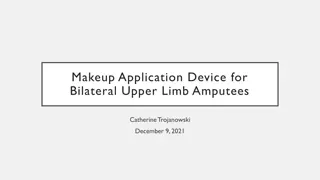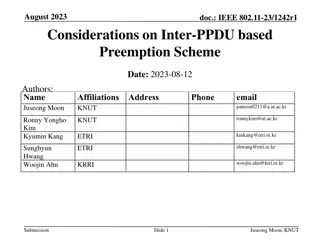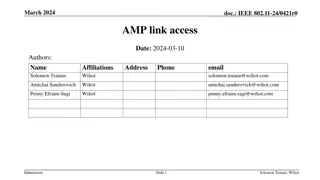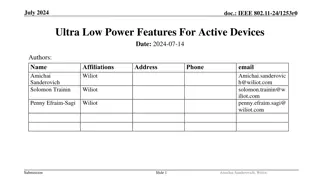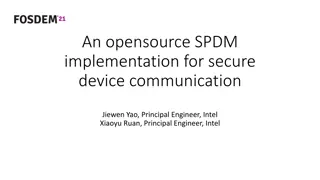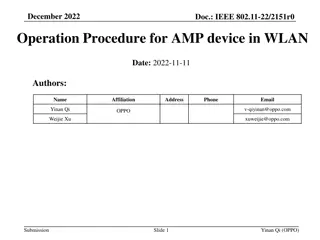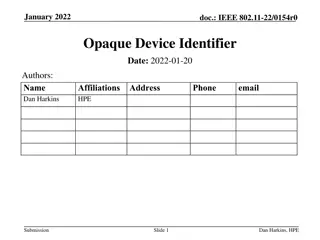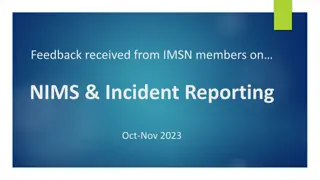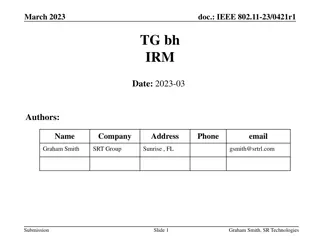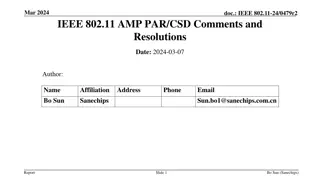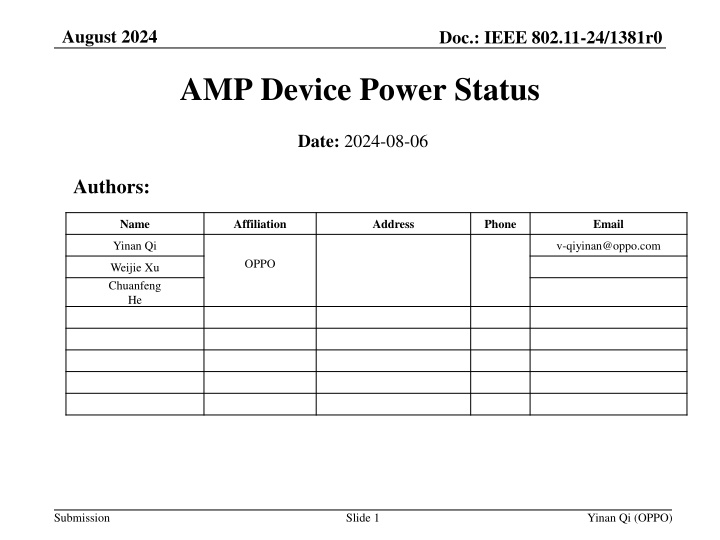
Proposed Scheme for AMP Device Power Status Reporting
In this contribution, the focus is on defining power status for AMP devices and proposing a scheme for AMP devices to report their power status. The discussion revolves around the importance of power status in facilitating channel access and wireless power transfer (WPT) in IEEE 802.11 networks. Challenges related to AMP devices' power consumption and priority in channel access are addressed, emphasizing the need for efficient energy management. Various power status definitions based on long-term and short-term power features of AMP devices are explored, considering factors like energy harvesting capability and storage capacity. The content emphasizes the significance of considering multiple power features for AMP devices to optimize channel access and WPT efficiency.
Download Presentation

Please find below an Image/Link to download the presentation.
The content on the website is provided AS IS for your information and personal use only. It may not be sold, licensed, or shared on other websites without obtaining consent from the author. If you encounter any issues during the download, it is possible that the publisher has removed the file from their server.
You are allowed to download the files provided on this website for personal or commercial use, subject to the condition that they are used lawfully. All files are the property of their respective owners.
The content on the website is provided AS IS for your information and personal use only. It may not be sold, licensed, or shared on other websites without obtaining consent from the author.
E N D
Presentation Transcript
August 2024 Doc.: IEEE 802.11-24/1381r0 AMP Device Power Status Date: 2024-08-06 Authors: Name Affiliation Address Phone Email Yinan Qi v-qiyinan@oppo.com OPPO Weijie Xu Chuanfeng He Submission Slide 1 Yinan Qi (OPPO)
Doc.: IEEE 802.11-24/1381r0 August 2024 Abstract In this contribution, we discuss the definition of power status for AMP devices and propose a scheme for AMP devices to report its own power status to facilitate channel access and WPT. Submission Slide 2 Yinan Qi (OPPO)
August 2024 Doc.: IEEE 802.11-24/1381r0 Challenges for AMP Devices Channel access In 802.11 Wi-Fi networks, traffic categories are defined to refer to different classes or priorities assigned to various types of network traffic. In general, traffic with high priority can access the channel faster and thus QoS can be guaranteed. AMP is set with AC-BK priority, e.g., the lowest priority [1]. Among AMP devices, we might also need to consider different priority. In AMP, power consumption is an essential issue since some devices may not have strong energy harvesting capability or super capacitor for energy storage. Such AMP devices should be given higher priority to access channel because long channel access time may drain the power of such devices. In some extreme cases, these devices may need to wait for additional long time to store sufficient power for another channel access procedure. WPT Either periodic or on demand On demand should be requested by AMP devices explicitly or implicitly Submission Slide 3 Yinan Qi (OPPO)
August 2024 Doc.: IEEE 802.11-24/1381r0 Power Status Definition Power status can be defined based on both the long-term or short term power features of the AMP devices and one power status can be assigned with certain channel access priority. Long term power feature example Low-level: devices with extremely limited energy harvesting and power storage capability; Mid-level: devices with limited energy harvesting and power storage capability; High-level: devices with reasonable energy harvesting and power storage capability. For a single device, short term power feature, e.g., remaining power can also be considered to define power status. Channel access: AMP devices with stringent power limit can be configured with higher priority to access the channel to mitigate the latency and fairness issue. WPT: can be triggered by power status implicitly, e.g., power status indicating low remaining power Submission Slide 4 Yinan Qi (OPPO)
August 2024 Doc.: IEEE 802.11-24/1381r0 Long Term Power Features Considered Multiple power features of AMP devices should be taken into account. Energy harvesting capability including Power source(s) Energy harvesting efficiency Energy storage capability Whether or not energy storage is supported; The amount of energy that can be stored; Energy storage draining rate; Others RF energy harvesting operation frequency Submission Slide 5 Yinan Qi (OPPO)
August 2024 Doc.: IEEE 802.11-24/1381r0 Power Status Report Power status can be reported to the AP so that AP can configure channel access priority and AP/Energizer can conduct WPT. For example, AMP devices can report/suggest their own initial power status and AP can determines the actual power status and signals the AMP devices. AP can decide whether or not to do WPT based on power status report. Submission Slide 6 Yinan Qi (OPPO)
August 2024 Doc.: IEEE 802.11-24/1381r0 Summary In this submission, we discuss power status definition and report for AMP: Channel access priority and WPT can depend on power status AMP devices can report their power status to the AP for the AP to determine channel access priority when activating/scheduling the AMP devices . Submission Slide 7 Yinan Qi (OPPO)
August 2024 Doc.: IEEE 802.11-24/1381r0 Reference [1] p802.11bp-PAR, IEEE 802.11-24/0575r1, March 2024 Submission Slide 8 Yinan Qi (OPPO)


